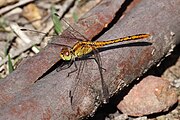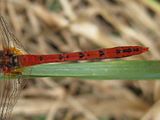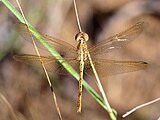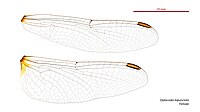Diplacodes bipunctata
| Wandering percher | |
|---|---|

| |
| Male | |

| |
| Female | |
| Scientific classification | |
| Domain: | Eukaryota |
| Kingdom: | Animalia |
| Phylum: | Arthropoda |
| Class: | Insecta |
| Order: | Odonata |
| Infraorder: | Anisoptera |
| Family: | Libellulidae |
| Genus: | Diplacodes |
| Species: | D. bipunctata
|
| Binomial name | |
| Diplacodes bipunctata | |

| |
Diplacodes bipunctata is a species of dragonfly in the family Libellulidae,[3] known as the wandering percher[4] or red percher dragonfly.[1]
Description
Diplacodes bipunctata is a small to medium-sized dragonfly with a wingspan of about 55 millimeters. The wings are colorless except for a yellowish spot at the base of the hindwing. The male has a bright orange or red abdomen with dark markings along the dorsal line and sides, and the female is yellowish with similar markings. There are two dark spots at the side of the synthorax, one of which is the metastigma.[4]
Range
In Australia it is found throughout the continent except in Tasmania. It is found near a wide variety of freshwater pools, streams and swamps.[4]
Biology
This species is an early colonizer of appropriate habitat types in freshwater and brackish waters.[1]
Gallery
-
Female
-
Female
-
Immature male
-
Male
-
Immature male
-
Male with outspread wings
-
Male tail
-
6. Diplacodes bipunctata from Australian Insects 1907, by W.W. Froggatt
-
Adult female from above
-
Female wings
-
Male wings
References
- ^ a b c Rowe, R. & Marinov, M. (2013). "Diplacodes bipunctata". IUCN Red List of Threatened Species. 2013: e.T197099A2480508. doi:10.2305/IUCN.UK.2013-1.RLTS.T197099A2480508.en.
{{cite journal}}: CS1 maint: multiple names: authors list (link) - ^ Brauer, F. (1865). "Dritter Bericht über die auf der Weltfahrt der kais. Fregatte Novara gesammelten Libellulinen". Verhandlungen der Zoologisch-Botanischen Gesellschaft in Wien (in German). 15: 501–512 [503] – via Biodiversity Heritage Library.
- ^ "Species Diplacodes bipunctata (Brauer, 1865)". Australian Faunal Directory. Australian Biological Resources Study. 2012. Retrieved 28 February 2017.
- ^ a b c Theischinger, G; Hawking, J (2006). The Complete Field Guide to Dragonflies of Australia. Collingwood Vic.: CSIRO Publishing. p. 276. ISBN 978 0 64309 073 6.












